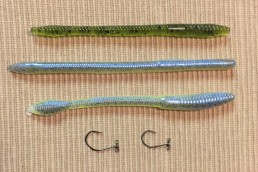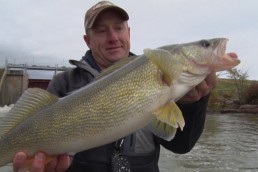Drifting Crankbaits for River Success
SHARE THIS POST
It seems like many fishing techniques, rig designs, and bait presentations are developed and honed to perfection through countless hours of testing on and off the water while others are just stumbled upon. Their intent involves the old saying: “Even a blind ‘hog’ finds an acorn every now and then.” Yes—I don’t know about that saying either. Anyway, this technique I use pretty much was spawned from the “hog” concept.
I was fishing the Kankakee River one day, trying to fish a particular large slack-water area downstream from an underwater obstruction. I noticed a fish had come up and had broken the surface and was feeding on something in that area. Due to the current flow and my position on the bank, the angle was tough to get the bait exactly where it needed to be. With casting not giving me the position I was looking for, I then moved upstream for more of a straight-upstream position from the slack water. I was able to cast and keep the topwater popper in the middle of the pool by letting the current carry the bait to my intended spot. I then stopped the bait, made a couple of pops, and then something came up, boiled, and then went back down.
This repeated a couple more times.
Knowing that a decent fish of some type was still there, I changed baits, tied on a Strike King Shallow Runner Crankbait and followed the same approach. And, upon entering the slack water, I held back on the crankbait and let the current and my “holding back” allow my offering to dive a foot or so—then I connected with a 2-pound smallmouth.
Happy with the catch, I repeated the cast again and another smallie came back to see me. A total of six smallies and two walleyes came out of that spot. I used the same technique in several more spots, with the same results, and a new concept was born.
Floating or using the drift on moving waters is nothing new. In fact, I’ve used the current when float fishing for years and many fly-fishing anglers do the same when working a fly. I just never used the current to carry my baits into these slack-water areas in this manner in the past—but I do now. Now, some of my river rat friends are going to tell me I’m fishing “backward” and should be downstream from my target areas. I agree, and normally I do, but let me have this one oddball technique please!
Again, I happened upon this technique while using a Strike King Shallow Runner. And while it and other floating crankbaits do work, from my experiments, I’ve settled on the Rapala Shallow Scatter Rap Shad and Scatter Rap Crank for most angling in these situations. Traditional Rapala Floating Minnows work well on most rivers and work in this approach, but I’ve had much more success with the crankbait-style body.
The Scatter Rap in the Shad and Crank styles are balsa wood baits as opposed to plastic crankbaits. I believe it’s their buoyancy and faster rise to the surface that might be the difference. The two baits differ in that the Shad has a smaller, slender body, while the Crank is thicker and has a bit of a “beefier” profile.
When it comes to the action on these two baits, they are similar. But it may really depend on the day and where one might be a bit more productive than the other. For color, you know I don’t get into this too much. I like more natural tones, but through many days on the water with these baits, a mix of gold, yellow, greens and browns are my go-to colors with the occasional hint of orange. You really need to experiment in your own waters. I believe we focus too much on color variations in baits; I’m a believer that body profile and vibration are a bigger factor than color.
As a side note on river fish: I believe these have far less time to follow or study a bait than their still-water counterparts. Food opportunities on most rivers usually never allow for more than a quick glimpse in the current, and they usually evoke a strike or no response. Slow-responding fish or picky eaters on rivers usually go hungry. Working a floating crankbait in this situation by holding the bait in the slack water for a few more seconds gives the fish, no matter the species, a little more time to react, especially if the water is a little stained.
Let’s talk equipment. My choice of rod and reel are a bit of a departure from the norm here. But for most river angling, regardless of species or technique, I rely on long rods, mostly spinning rods, and the appropriate reels. For my light approaches I favor 12- to 13-foot fishing rods or float rods. But for this situation and others I depend on stouter rods while on a river system.
Are you enjoying this post?
You can be among the first to get the latest info on where to go, what to use and how to use it!
While I’m not fishing extreme rods in length with these crankbaits, I have found a few to match my technique. One is a St. Croix Triumph, 8-foot 6-inch Heavy Power Series spinning rod. The other, and my favorite for sure, is St. Croix’s Avid medium- heavy-spinning rod. Both rods come from the salmon and steelhead category. They are heavily backboned rods, and ones that are not to be confused with the popular longer noodle rods of the same lengths.
So, why the long rods?
Longer rods allow you to control the drift of your bait presentation by letting you keep your slack line out of the current. A shorter rod allows for too much surface line “lay,” causing you to lose control of your bait’s drift as your line is swept downstream. After a cast, just keep the rod tip up whatever the presentation.
Here’s another suggestion: always use high-visibility line. For this technique, I use Sufix Elite 10-pound-test High Visibility Yellow mono. This line allows me to visually follow my slack line with ease and actually helps me pinpoint my bait in the current. Most river fish are not line shy, so use the high-vis. line to your advantage.
I kind of explained the technique in the beginning, but here’s a quick recap: Seek out some potential slack-water areas. My primary focus is on those with some deeper water behind your obstruction creating the slack area. Deep is really relevant to your own particular body of water, but for most of my targets if I can find 2-4 feet downstream I’m pretty confident that it holds some decent fish. I use floating crankbaits in the 2- to 5-foot diving depths, which both my Scatter Shallow Shad Rap and Scatter Shallow Crank Rap will achieve.
Another thing to point out is that I’m not making extremely, halfway-across-the-river casts with this presentation. Keep the casts close, as this allows for so much more control over your baits. Simply cast your bait out upstream from the slack water and allow the current to carry your bait into the “fish zone.” Once near the rear of the slack area, simply lift up and hold back with your rod and allow the crankbait to dive down. If there’s no hit, point your rod tip back toward your bait, giving it line to allow the bait to surface. Then repeat. It’s really that easy, and how long you work an area is up to you. I’m in and out pretty quick in search of my next potential hot spot.
While I didn’t discuss it, this is a multi-species approach. I have caught smallmouths, largemouths, walleyes, pike, crappies and cats using these baits and this technique, often sharing the same spot. The mystery of what has congregated in these slack-water areas just adds to the excitement of the outing.
If you have never fished moving waters in the past and have dealt with current, this all might sound a bit confusing or intimidating. Trust me. It’s not. Take your time and learn to read the water.
These next couple of months this summer will be an outstanding time to hit some of these fish-holding areas on rivers. River fish always seem to be on the bite, even when some other waters this time of year have slowed.
MWO
SHARE THIS POST
Did you enjoy this post?
You can be among the first to get the latest info on where to go, what to use and how to use it!
Dan Brozowski
Passion for angling drives Dan Brozowski to the water’s edge virtually any chance he gets. Although passion cannot be measured, weighed, or recorded, it can be shared. He does this through his writing and while on the water. If you have any questions or comments for Dan, you may contact him at: onthebank@att.net.



